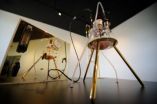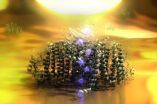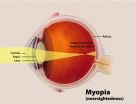(Press-News.org) EAST LANSING, Mich. — At a time when the value of gold has reached an all-time high, Michigan State University researchers have discovered a bacterium's ability to withstand incredible amounts of toxicity is key to creating 24-karat gold.
"Microbial alchemy is what we're doing – transforming gold from something that has no value into a solid, precious metal that's valuable," said Kazem Kashefi, assistant professor of microbiology and molecular genetics.
He and Adam Brown, associate professor of electronic art and intermedia, found the metal-tolerant bacteria Cupriavidus metallidurans can grow on massive concentrations of gold chloride – or liquid gold, a toxic chemical compound found in nature.
In fact, the bacteria are at least 25 times stronger than previously reported among scientists, the researchers determined in their art installation, "The Great Work of the Metal Lover," which uses a combination of biotechnology, art and alchemy to turn liquid gold into 24-karat gold. The artwork contains a portable laboratory made of 24-karat gold-plated hardware, a glass bioreactor and the bacteria, a combination that produces gold in front of an audience.
Brown and Kashefi fed the bacteria unprecedented amounts of gold chloride, mimicking the process they believe happens in nature. In about a week, the bacteria transformed the toxins and produced a gold nugget.
"The Great Work of the Metal Lover" uses a living system as a vehicle for artistic exploration, Brown said.
In addition, the artwork consists of a series of images made with a scanning electron microscope. Using ancient gold illumination techniques, Brown applied 24-karat gold leaf to regions of the prints where a bacterial gold deposit had been identified so that each print contains some of the gold produced in the bioreactor.
"This is neo-alchemy. Every part, every detail of the project is a cross between modern microbiology and alchemy," Brown said. "Science tries to explain the phenomenological world. As an artist, I'm trying to create a phenomenon. Art has the ability to push scientific inquiry."
It would be cost prohibitive to reproduce their experiment on a larger scale, he said. But the researchers' success in creating gold raises questions about greed, economy and environmental impact, focusing on the ethics related to science and the engineering of nature.
"The Great Work of the Metal Lover" was selected for exhibition and received an honorable mention at the world-renowned cyber art competition, Prix Ars Electronica, in Austria, where it's on display until Oct. 7. Prix Ars Electronica is one of the most important awards for creativity and pioneering spirit in the field of digital and hybrid media, Brown said.
"Art has the ability to probe and question the impact of science in the world, and 'The Great Work of the Metal Lover' speaks directly to the scientific preoccupation while trying to shape and bend biology to our will within the postbiological age," Brown said.
INFORMATION:
Michigan State University has been working to advance the common good in uncommon ways for more than 150 years. One of the top research universities in the world, MSU focuses its vast resources on creating solutions to some of the world's most pressing challenges, while providing life-changing opportunities to a diverse and inclusive academic community through more than 200 programs of study in 17 degree-granting colleges.
Superman-strength bacteria produce gold
2012-10-02
ELSE PRESS RELEASES FROM THIS DATE:
Solar cell consisting of a single molecule
2012-10-02
This press release is available in German.
A team of scientists, led by Joachim Reichert, Johannes Barth, and Alexander Holleitner (Technische Universitaet Muenchen, Clusters of Excellence MAP and NIM), and Itai Carmeli (Tel Aviv University) developed a method to measure photocurrents of a single functionalized photosynthetic protein system. The scientists could demonstrate that such a system can be integrated and selectively addressed in artificial photovoltaic device architectures while retaining their biomolecular functional properties. The proteins represent light-driven, ...
Specialty contact lenses may one day help halt the progression of nearsightedness in children
2012-10-02
WASHINGTON, Oct. 2—Nearsightedness, or myopia, affects more than 40 percent of people in the U.S. and up to 90 percent of children in some parts of Asia. The problem begins in childhood and often progresses with age. Standard prescription lenses can correct the defocus but do not cure nearsightedness, and do not slow progression rates as children grow. But recent experimental work by biomedical scientist David Troilo and colleagues at the State University of New York (SUNY) College of Optometry in New York City supports the development of a potential cure for myopia by ...
3-D medical scanner: New handheld imaging device to aid doctors on the 'diagnostic front lines'
2012-10-02
WASHINGTON, Oct. 2, 2012—In the operating room, surgeons can see inside the human body in real time using advanced imaging techniques, but primary care physicians, the people who are on the front lines of diagnosing illnesses, haven't commonly had access to the same technology – until now. Engineers from the University of Illinois at Urbana-Champaign (UIUC) have created a new imaging tool for primary care physicians: a handheld scanner that would enable them to image all the sites they commonly examine, and more, such as bacterial colonies in the middle ear in 3-D, or monitor ...
Sea Education Association tall ship departs on major marine debris research cruise
2012-10-02
(San Diego, California – October 2, 2012) A tall ship owned and operated by Sea Education Association (SEA) will depart port tomorrow on a research expedition dedicated to examining the effects of plastic marine debris, including debris generated by the 2011 Japanese tsunami, in the ocean ecosystem.
During their 37-day cruise, the crew of the Woods Hole, Mass.-based sailing oceanographic research vessel Robert C. Seamans will explore a region between San Diego and Honolulu, popularly dubbed the "Great Pacific Garbage Patch", where high concentrations of plastic debris ...
RI Hospital: Differences in diagnosis, treatment of nonepileptic seizures in US, Chile
2012-10-02
PROVIDENCE, R.I. – Epileptic and psychogenic nonepileptic seizures (PNES) may look similar, but actually have different causes and treatments. Up to 20 percent of patients diagnosed with epilepsy actually have PNES, which are not treated by antiepileptic drugs (AEDs). According to a new study by Rhode Island Hospital researcher W. Curt LaFrance Jr., M.D., M.P.H., director of neuropsychiatry and behavioral neurology, increasing access to video electroencephalography (video-EEG) may aid in distinguishing between epilepsy and PNES. The study is published online in advance ...
Gene responsible for many spontaneous breast cancers identified
2012-10-02
BETHESDA, MD – October 2, 2012 -- Cancerous tumors contain hundreds of mutations, and finding these mutations that result in uncontrollable cell growth is like finding the proverbial needle in a haystack. As difficult as this task is, it's exactly what a team of scientists from Cornell University, the University of North Carolina, and Memorial Sloan-Kettering Cancer Center in New York have done for one type of breast cancer. In a report appearing in the journal GENETICS, researchers show that mutations in a gene called NF1 are prevalent in more than one-fourth of all noninheritable ...
Amazonian tribal warfare sheds light on modern violence, says MU anthropologist
2012-10-02
In the tribal societies of the Amazon forest, violent conflict accounted for 30 percent of all deaths before contact with Europeans, according to a recent study by University of Missouri anthropologist Robert Walker. Understanding the reasons behind those altercations in the Amazon sheds light on the instinctual motivations that continue to drive human groups to violence, as well as the ways culture influences the intensity and frequency of violence.
"The same reasons - revenge, honor, territory and jealousy over women - that fueled deadly conflicts in the Amazon continue ...
Manatees reflect quality of health in marine ecosystems, longterm study finds
2012-10-02
FAIRFAX, Va., October 1, 2012—A longterm study conducted by researchers at George Mason University may be a benchmark in determining health threats to marine mammals.
Over ten years of research in Belize was conducted studying the behavioral ecology, life history and health of manatees in an area relatively undisturbed by humankind.
"Manatees are the proverbial 'canaries in the mineshaft,' as they serve as indicators of their environment and may reflect the overall health of marine ecosystems," says Alonso Aguirre, executive director of the Smithsonian-Mason School ...
Adult stem cells change their epigenome to generate new organs
2012-10-02
The team led by Manel Esteller, director of the Cancer Epigenetics and Biology Program in the Bellvitge Biomedical Research Institute (IDIBELL), Professor of Genetics at the University of Barcelona and ICREA researcher, has identified epigenetic changes that occur in adult stem cells to generate different body tissues. The finding is published this week in The American Journal of Pathology.
The genome of every single cell in the human body is the same, regardless of their appearance and function. Therefore the activity of the tissues and organs and its disorders in complex ...
Hopkins study suggests treatments for 'wet' AMD keep elderly drivers behind the wheel
2012-10-02
The advanced neovascular, or "wet," form of age-related macular degeneration (AMD), left untreated, is the most common cause of vision loss among the elderly and a leading reason for their loss of driving privileges. But results of a new study, published in the online version of the journal Ophthalmology, suggest that monthly injections of ranibizumab improve eye chart test results required for a driver's license, build driver confidence and keep those with AMD driving longer.
The wet form of AMD is marked by the abnormal scarring and leaking of new blood vessels in ...



